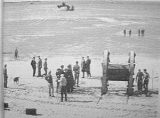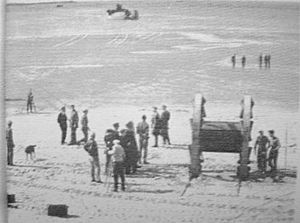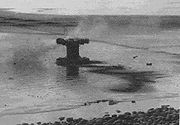
Panjandrum
Encyclopedia

World War II
World War II, or the Second World War , was a global conflict lasting from 1939 to 1945, involving most of the world's nations—including all of the great powers—eventually forming two opposing military alliances: the Allies and the Axis...
. It was one of a number of highly experimental projects, including Hajile
Hajile
Hajile was one of a number of highly experimental projects, including the Hedgehog and Panjandrum, that were developed by the British Admiralty's Directorate of Miscellaneous Weapons Development during the final years of World War II...
and the Hedgehog
Hedgehog (weapon)
The Hedgehog was an anti-submarine weapon developed by the Royal Navy during World War II, that was deployed on convoy escort warships such as destroyers to supplement the depth charge. The weapon worked by firing a number of small spigot mortar bombs from spiked fittings...
, that were developed by the Admiralty
Admiralty
The Admiralty was formerly the authority in the Kingdom of England, and later in the United Kingdom, responsible for the command of the Royal Navy...
's Directorate of Miscellaneous Weapons Development
Directorate of Miscellaneous Weapons Development
The Directorate of Miscellaneous Weapons Development , known colloquially as the Wheezers and Dodgers, was a department of the Admiralty responsible for the development of various unconventional weapons during World War II...
(DMWD) in the final years of the war. The Panjandrum was never used in battle.
Development
The DMWD had been asked to come up with a device capable of penetrating the 10 feet (3 m), 7 feet (2.1 m) concreteConcrete
Concrete is a composite construction material, composed of cement and other cementitious materials such as fly ash and slag cement, aggregate , water and chemical admixtures.The word concrete comes from the Latin word...
defences that made up part of the Atlantic Wall
Atlantic Wall
The Atlantic Wall was an extensive system of coastal fortifications built by Nazi Germany between 1942 and 1944 along the western coast of Europe as a defense against an anticipated Allied invasion of the mainland continent from Great Britain.-History:On March 23, 1942 Führer Directive Number 40...
. It was further specified that the device should be capable of being launched from landing craft
Landing craft
Landing craft are boats and seagoing vessels used to convey a landing force from the sea to the shore during an amphibious assault. Most renowned are those used to storm the beaches of Normandy, the Mediterranean, and many Pacific islands during WWII...
since it was highly likely that the beaches in front of the defences would act as a killing ground for anyone attempting to deliver the device by hand. Sub-Lieutenant
Sub-Lieutenant
Sub-lieutenant is a military rank. It is normally a junior officer rank.In many navies, a sub-lieutenant is a naval commissioned or subordinate officer, ranking below a lieutenant. In the Royal Navy the rank of sub-lieutenant is equivalent to the rank of lieutenant in the British Army and of...
Nevil Shute
Nevil Shute
Nevil Shute Norway was a popular British-Australian novelist and a successful aeronautical engineer. He used his full name in his engineering career, and 'Nevil Shute' as his pen name, in order to protect his engineering career from any potential negative publicity in connection with his novels.-...
calculated that over 1 long ton of explosives would be needed in order to create a tank-sized breach in such a wall. The delivery method for such a quantity of explosives posed a significant problem, and one of the concepts discussed ultimately resulted in the construction of the prototype "Great Panjandrum". The proposed device was composed of two gigantic wooden wheels, ten feet in diameter with steel treads a foot wide, joined by a central drum fitted with the explosive payload. It was to be propelled by sets of cordite
Cordite
Cordite is a family of smokeless propellants developed and produced in the United Kingdom from 1889 to replace gunpowder as a military propellant. Like gunpowder, cordite is classified as a low explosive because of its slow burning rates and consequently low brisance...
rockets attached to each wheel. It was predicted that when deployed with a full 4000 pounds (1,814.4 kg) load, Panjandrum would achieve speeds of around 60 mph (26.8 m/s), simply crashing through any obstacles to reach its target. The name "Great Panjandrum" was chosen by Shute as a reference to Samuel Foote
Samuel Foote
Samuel Foote was a British dramatist, actor and theatre manager from Cornwall.-Early life:Born into a well-to-do family, Foote was baptized in Truro, Cornwall on 27 January 1720. His father, John Foote, held several public positions, including mayor of Truro, Member of Parliament representing...
's famous extempore nonsense
Literary nonsense
Literary nonsense is a broad categorization of literature that uses sensical and nonsensical elements to defy language conventions or logical reasoning...
paragraph (though Foote's term was actually "the grand Panjandrum"), and in particular to its closing line "till the gunpowder ran out at the heels of their boots".
Testing

Leytonstone
Leytonstone is an area of east London and part of the London Borough of Waltham Forest. It is a high density suburban area, located seven miles north east of Charing Cross in the ceremonial county of Greater London and the historic county of Essex...
and transported by night to the testing grounds at Westward Ho!
Westward Ho!
Westward Ho! is a seaside village near Bideford in Devon, England. The A39 road provides access from the towns of Barnstaple, Bideford and Bude...
, Devon
Devon
Devon is a large county in southwestern England. The county is sometimes referred to as Devonshire, although the term is rarely used inside the county itself as the county has never been officially "shired", it often indicates a traditional or historical context.The county shares borders with...
. However, once there the secrecy surrounding the project broke down, as the beach chosen as a test site was also a popular destination for holidaymakers and from the first test on September 7, 1943 onwards, every trial was witnessed by large citizen audiences despite the DMWD's warnings concerning the safety of the weapon. Since nothing remotely resembling the Panjandrum had ever been constructed before, the trials began with a good degree of trepidation — only a handful of cordite rockets were attached to the wheels, and the payload was simulated by an equivalent weight of sand
Sand
Sand is a naturally occurring granular material composed of finely divided rock and mineral particles.The composition of sand is highly variable, depending on the local rock sources and conditions, but the most common constituent of sand in inland continental settings and non-tropical coastal...
. When Shute gave the signal, the rockets were ignited and the Panjandrum catapulted itself forward, out of the landing craft used as a launchpad, and a fair distance up the beach before a number of the rockets on the right wheel failed and the weapon careered off course. Several further attempts were made with more and more rockets, but on every occasion the Panjandrum lost control before reaching the end of the beach.
After tinkering with the project for a further three weeks, the Department returned to the beach. Panjandrum was now equipped with over seventy cordite rockets and a stabilising third wheel. When launched, it hurtled towards the coast, skimming the beach before turning back out to sea. A number of the 20 lb (9.1 kg) rockets detached and whipped wildly above the heads of the gathered audience or exploded underwater. Despite these failures, Shute and his team persevered, removing the third wheel and attaching steel cables to the remaining two wheels as a basic form of steering. Panjandrum proved to be too powerful however, snapping the cables and whipping them back across the beach when they were used. More weeks were spent testing every conceivable variable from thicker cables to heavier rocket-clamps without success before the DMWD received notification that the weapon was only required to be consistently able to travel in the general direction of the enemy. With some degree of confidence, a final trial was scheduled to be performed in January, 1944, in front of a number of Navy officials and scientists, as well as an official photographer.
The final test

BBC
The British Broadcasting Corporation is a British public service broadcaster. Its headquarters is at Broadcasting House in the City of Westminster, London. It is the largest broadcaster in the world, with about 23,000 staff...
documentary Secret War:
- "At first all went well. Panjandrum rolled into the sea and began to head for the shore, the Brass Hats watching through binoculars from the top of a pebble ridge [...] Then a clamp gave: first one, then two more rockets broke free: Panjandrum began to lurch ominously. It hit a line of small craters in the sand and began to turn to starboard, careering towards Klemantaski, who, viewing events through a telescopic lens, misjudged the distance and continued filming. Hearing the approaching roar he looked up from his viewfinder to see Panjandrum, shedding live rockets in all directions, heading straight for him. As he ran for his life, he glimpsed the assembled admirals and generals diving for cover behind the pebble ridge into barbed-wire entanglements. Panjandrum was now heading back to the sea but crashed on to the sand where it disintegrated in violent explosions, rockets tearing across the beach at great speed."
Given the results of the trial, it is perhaps not surprising that the project was scrapped almost immediately over safety concerns. However, it has since been claimed that the entire project was a hoax devised as part of Operation Fortitude
Operation Fortitude
Operation Fortitude was the codename for a World War II military deception employed by the Allied nations as part of an overall deception strategy during the build up to the 1944 Normandy Landings...
, to convince the Germans that plans were being developed to attack the heavily fortified defences surrounding the Pas-de-Calais rather than the less-defended Normandy
Normandy
Normandy is a geographical region corresponding to the former Duchy of Normandy. It is in France.The continental territory covers 30,627 km² and forms the preponderant part of Normandy and roughly 5% of the territory of France. It is divided for administrative purposes into two régions:...
coastline. In particular, the near-complete lack of security surrounding the tests themselves is cited as proof that the Allies wished German spies to know about the project.
Reconstruction
On the occasion of the 65th anniversary of the Normandy Landings a replica was constructed and set off on the original beach in Devon. The wheel, commissioned by the local Appledore Book Festival, was 6 feet high and 3 feet wide and loaded with fireworks fitted by Skyburst of Bristol, instead of explosives; it was expected to travel 500 metres at a speed of up to 24 km/h. In the event, it travelled in a straight line, but only for 50 metres. A video of the event .Popular culture
Although not named as Panjandrum, a similar device was the focus of an episode of the comedy Dad's ArmyDad's Army
Dad's Army is a British sitcom about the Home Guard during the Second World War. It was written by Jimmy Perry and David Croft and broadcast on BBC television between 1968 and 1977. The series ran for 9 series and 80 episodes in total, plus a radio series, a feature film and a stage show...
, "Round and Round Went the Great Big Wheel
Round and Round went the Great Big Wheel
"Round and Round went the Great Big Wheel" is the twelfth episode of the fifth series of the British comedy series Dad's Army that was originally transmitted on the 22 December 1972.-Synopsis:...
". The device malfunctions in a similar way to the original, although it was operated by remote control and for comic purposes it is more manoeuvrable and remains active far longer.
The Panjandrum tests are featured in the film Overlord
Overlord (film)
Overlord is a 1975 black-and-white film written and directed by Stuart Cooper. Set around the D-Day invasion , Overlord is a war film about a young soldier's meditations on being part of the war machinery, and his premonitions of death...
by Stuart Cooper
Stuart Cooper
Stuart W. Cooper is an American filmmaker, actor and writer.Cooper was a resident in the United Kingdom in the 1960s and 1970s where his most notable film appearance was as one of The Dirty Dozen, Roscoe Lever....
.
The Panjandrum was mentioned in The Right Stuff
The Right Stuff (book)
The Right Stuff is a 1979 book by Tom Wolfe about the pilots engaged in U.S. postwar experiments with experimental rocket-powered, high-speed aircraft as well as documenting the stories of the first Project Mercury astronauts selected for the NASA space program...
by Tom Wolfe
Tom Wolfe
Thomas Kennerly "Tom" Wolfe, Jr. is a best-selling American author and journalist. He is one of the founders of the New Journalism movement of the 1960s and 1970s.-Early life and education:...
.
Footage from the final test is shown in Episode 17 of the ITV documentary series The World at War.
The Panjandrum is mentioned as the cause of the character England's illness in a strip from Axis Powers Hetalia. It is also mentioned along with the Busby Stoop Chair in England's character song, 'Pub & Go!'.
External links
- "The Great Panjandrum" by Samuel FooteSamuel FooteSamuel Foote was a British dramatist, actor and theatre manager from Cornwall.-Early life:Born into a well-to-do family, Foote was baptized in Truro, Cornwall on 27 January 1720. His father, John Foote, held several public positions, including mayor of Truro, Member of Parliament representing...
, on WikisourceWikisourceWikisource is an online digital library of free content textual sources on a wiki, operated by the Wikimedia Foundation. Its aims are to host all forms of free text, in many languages, and translations. Originally conceived as an archive to store useful or important historical texts, it has...
. - Eye witness account by Thomas William Leeson On BBC WW2 People.
- John Garth: "The Great Panjandrum rolls again… Secret weapon designed for D-Day roars back to life for anniversary", 5 June 2009, Daily MailDaily MailThe Daily Mail is a British daily middle-market tabloid newspaper owned by the Daily Mail and General Trust. First published in 1896 by Lord Northcliffe, it is the United Kingdom's second biggest-selling daily newspaper after The Sun. Its sister paper The Mail on Sunday was launched in 1982...
(with video)

